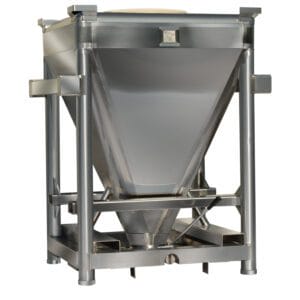Containment Solutions IBC IBC Containers and Bins The original IBC Containers (Intermediate Bulk Container) was made from plywood in 1937 for the storage and handling...
Read MoreBlending baffles are one of the most misunderstood principles in IBC Tumble Blending. The purpose of this paper is to dispel the myths surrounding them and identify when they can be beneficial.
A. What is a blending baffle?
Blending baffles are paddles, plates or bars placed inside Intermediate Bulk Containers (IBC or Bins) that can be either static (non-moving) or powered rotation type. The baffle provides an obstruction in the IBC causing the contents to be redirected as the IBC is tumble blended.
B. Why are blending baffles used?
Reason #1 – Baffles are added to IBCs for the “perceived” benefit of enhancing blend uniformity. Notice that the term “perceived” is used because in actual practice, regardless of baffle type, the blend uniformity will suffer. This seems counterintuitive to most people since “certainly something is needed inside an IBC to get the ingredients to mix?” This is a correct assumption when dealing with liquids and it would seem to be common sense as everyone has used a hand mixer in the kitchen. The difference here is that liquids and dry powders react very different to agitation. Dry powders do not have any cohesion to bind the blended ingredients as do liquid blends.
Reason #2 – To extend the effective IBC fill range. Baffles allow the IBC to have fill volume down to 25% of the total capacity vs. 50% of total IBC volume of an IBC without a baffle. IBCs that have less than 50% fill do not have adequate volume needed to produce the cross flow induced by the IBC geometry. The baffle serves as an obstacle for product to flow around to produce some level of agitation, albeit not nearly as effective the cross flow principle. Blend Baffles may be an attractive alternative for companies that have a wide range of batch sizes since the larger fill range of the baffled IBC reduces the number of different capacity IBCs needed. Please note that this is a compromise solution and product specific evaluations should be performed since blend quality will not be as good as an un-baffled IBC as described above.
Reason #3 – Cylindrical body IBCs. Baffles are needed in cylindrical body IBCs since they have no inherent mechanism to produce cross flow. Square or rectangular body IBC are tumble blender skewed l5° to 30° on the rotational axis. This angle produces cross flow due to the straight wall sections at continuously changing opposing angles throughout the revolution.
C. Why do Blending Baffles reduce blend uniformity?
The area behind the baffle produces a void as product flows around it and becomes a pocket of free-fall induced segregation. Those familiar with the principle of free-fall induced segregation will recognize that a baffle creates the same effect but on a smaller scale with more repetition. Free-fall induced segregation is where a mass of uniformly blended material is allowed to make an uncontrolled fall (typically occurring in trough floor product transfers) that allow the larger dense particles to drop faster than low density fine particles.
D. How much do baffles degrade blend uniformity?
Typically the RSD (Relative Standard Deviation) will suffer by 2% to 3.5% (or more) when using a baffle system. For example, a properly designed rectangular IBC blending system with no blend baffles will achieve a .5% to 1.5% RSD on a robust formulation. The same system with blending baffles installed would have an RSD ranging from 2.5 to 4% RSD.
E. When should I consider using blend baffles?
Baffles would be helpful when blending batches that are 50% or less volume than the total volumetric capacity of the IBCs you have available. Baffles will enhance blending in cylindrical body IBCs. Please note again that in both cases baffles are a compromise since blend quality will not be as good as an un-baffled rectangular IBC.


